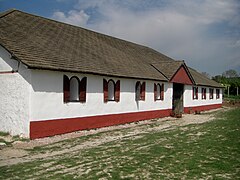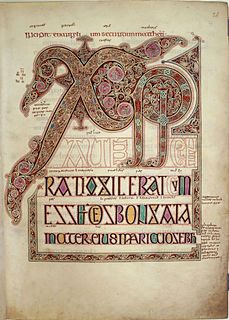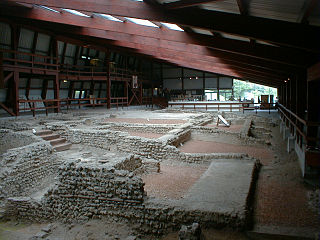
Lullingstone Roman Villa is a villa built during the Roman occupation of Britain, situated near the village of Eynsford in Kent, south eastern England. Constructed in the 1st century, perhaps around A. D. 80-90, the house was repeatedly expanded and occupied until it was destroyed by fire in the 5th century. The occupants were wealthy Romans or native Britons who had adopted Roman customs.

Fishbourne Roman Palace is in the village of Fishbourne, Chichester in West Sussex. The palace is the largest residential Roman building discovered in Britain and has an unusually early date of 75 AD, around thirty years after the Roman conquest of Britain. Its many superb mosaic floors dating from this period make it even more exceptional.
The year 1965 in archaeology involved some significant events.

The Villa Romana del Casale is a large and elaborate Roman villa or palace located about 3 km from the town of Piazza Armerina, Sicily. Excavations have revealed one of the richest, largest, and varied collections of Roman mosaics in the world, for which the site has been designated as a UNESCO World Heritage Site. The villa and artwork contained within date to the early 4th century AD.

Chedworth Roman Villa is a Roman villa located near Chedworth, Gloucestershire, England. It is one of the largest Roman villas in Britain. The villa was built in phases from the early 2nd century to the 4th century, with the 4th century construction transforming the building into an elite dwelling arranged around three sides of a courtyard. The 4th century building included a heated and furnished west wing containing a dining-room (triclinium) with a fine mosaic floor, as well as two separate bathing suites – one for damp-heat and one for dry-heat. The villa was discovered in 1864, and it was excavated and put on display soon afterwards. It was acquired in 1924 by the National Trust who have conducted a long-term conservation programme, with new on-site facilities and cover-buildings. It is debated amongst historians whether Chedworth was indeed a farm or in fact a religious hostel, as evidence has been found in support of both arguments. However most currently believe that Chedworth was a private farmstead, inhabited by a very wealthy Romano-Briton. It is a Scheduled monument.
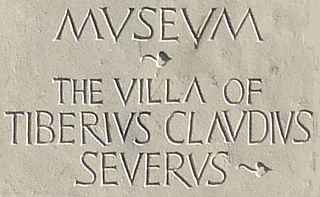
Piddington Roman Villa is the remains of a large Roman villa at Piddington, Northamptonshire, about 6 miles (9.7 km) south-east of Northampton.

Venta Silurum was a town in the Roman province of Britannia or Britain. Today it consists of remains in the village of Caerwent in Monmouthshire, south east Wales. Much of it has been archaeologically excavated and is on display to the public.
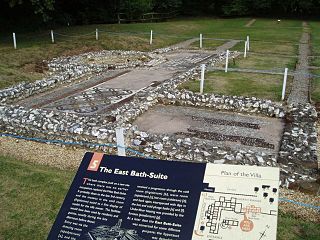
Rockbourne Roman Villa is a Roman courtyard villa excavated and put on public display in the village of Rockbourne in the English county of Hampshire. The villa was discovered in 1942 by a local farmer and excavated by A. T. Morley Hewitt over the next thirty years.
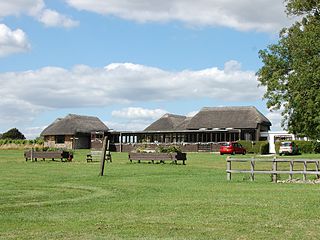
Bignor Roman Villa is a large Roman courtyard villa which has been excavated and put on public display on the Bignor estate in the English county of West Sussex. It is well known for its high quality mosaic floors, which are some of the most complete and intricate in the country.

Littlecote Roman Villa is a Roman winged corridor villa and associated religious complex at Littlecote Park in the civil parish of Ramsbury in the English county of Wiltshire. It has been archaeologically excavated under the direction of Bryn Walters, and is on display to the public.

The Low Ham Roman Villa was a Roman courtyard villa located near Low Ham in the civil parish of High Ham in the English county of Somerset. It is best known for the extraordinary figured mosaic depicting the story of Aeneas and Dido.
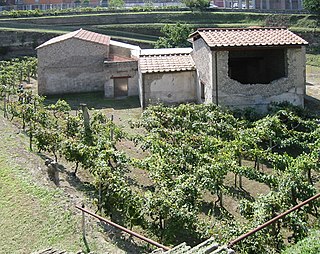
Many Roman villas have been discovered in the district of Boscoreale, Italy. They were all buried and preserved by the Eruption of Mount Vesuvius in 79 AD, along with Pompeii and Herculaneum. The only one visible in situ today is the Villa Regina, the others being reburied soon after their discovery. Nevertheless, among the most important finds from these others are the exquisite frescoes from the Villa of Publius Fannius Synistor and the sumptuous silver collection of the Villa della Pisanella, which are now displayed in several major museums, as are finds from the Villa del fondo Ippolito Zurlo. The name Villa Boscoreale is typically used for any one of these villas.

The Museum of Mosaics is a museum in the town of Devnya in Varna Province, northeastern Bulgaria. The museum, built on top of a large ruined Roman villa from Late Antiquity, exhibits mosaics from the Roman and early Byzantine city of Marcianopolis, as well as other archaeological artifacts.

North Leigh Roman Villa was a Roman courtyard villa in the Evenlode Valley about 0.5 miles (800 m) north of the hamlet of East End in North Leigh civil parish in Oxfordshire. It is in the care of English Heritage and is open to the public.

Bancroft Roman Villa is a Roman villa in the Bancroft district of Milton Keynes in Buckinghamshire, England. Originally a winged-corridor house, the villa eventually became a grand building with mosaics and a formal garden. The principal rooms have been marked out in Bancroft Park and the fish-pond has been reconstructed. One of the mosaics is on display in Central Milton Keynes Shopping Centre.

Spoonley Wood Roman Villa is an ancient Roman villa located 2 km south-east of Sudeley Castle near the village of Winchcombe, in Gloucestershire, England. It was a courtyard-type villa excavated in 1882. Some remains of the villa, partly reconstructed, can still be seen in Spoonley Wood, and one mosaic is viewable under a corrugated iron roof.
David E Johnston is a classical archaeologist and former lecturer at the University of Southampton. His excavations have included the Sparsholt Roman Villa, and he has authored numerous books and research papers on Roman archaeology, art and mosaics from the 1960s to the 2010s.
The Hampshire Field Club & Archaeological Society is a local history and archaeological society for Hampshire, England. It was founded in 1885 by Thomas W. Shore. It publishes a newsletter, monograms and other longer publications, and a journal Hampshire Studies: Proceedings of the Hampshire Field Club and Archaeological Society. The society has published the second series of Hampshire Papers since 2015, following on from the first series which was published by the Hampshire Record Office between 1991 and 2010.



